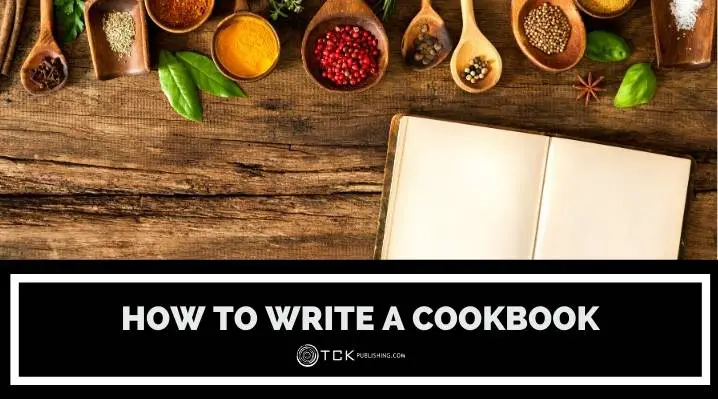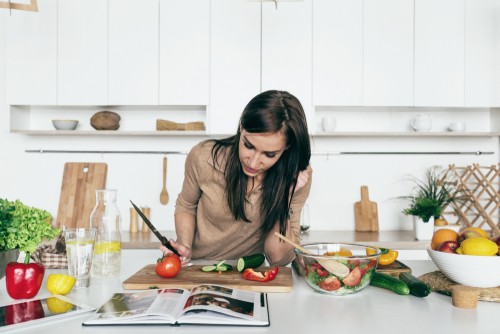
Do you have a passion for cooking up new concoctions in the kitchen, or making your loved ones smile with a warm plate of delicious comfort food? Or perhaps you have a collection of beloved family recipes that you’d like to share with the world, or even just future generations of your family?
All of these are great reasons to write a cookbook and spread the unmatched love that great food provides. Before you get started, however, there are some things you should know so you can be sure your recipes are ready to be savored by all.
How to Write a Cookbook
Follow these 8 steps as you set out to turn your cherished recipes into a collection that hundreds of readers can enjoy.
1. Define your theme and audience.
If you’re thinking about writing a cookbook, you probably have a general idea of what’s going to tie your book together. In other words, you’ve decided on your cookbook’s niche.
Now, I’m not saying that all of your recipes need to be Italian, or Persian, or start with the letter ‘C,’ or come from your mom’s kitchen. I’m just saying that you can’t really throw together a random book of recipes without identifying something that ties them together.
Maybe your recipes are all gluten-free, or can be prepared in under 30 mins, or for under $10. Maybe your recipes are for athletes who are training, or for busy parents who need simple, healthy meals that they can whip together quickly. Perhaps your recipes all come with stories from your travels around the world.
Think about what makes your recipes unique and who they are for. Do book market research to identify your target audience, and find comparable books in your genre or niche to study.
2. Set a budget.
Cookbooks can be very expensive to publish, whether you’re self-publishing or going the traditional route.
Before you start this project, set a clear budget, considering the costs of photography, printing, and distribution. (We’ll talk more about average costs below.) Your budget will help determine how many recipes you can include and how you should price your book.
3. Compile recipes.

Think about the theme or niche you decided on in Step 1. You’ll need to start compiling recipes that fit that theme, which means you may need to consider reworking recipes, experimenting with different versions or ingredients, etc.
It’s critical that your recipes are well-written. I don’t mean they should sound like Shakespeare wrote them; I mean they should be clear, practical, and very easy to follow. There’s no room for ambiguity here.
Be precise in your measurements and instructions, or you’ll find reviewer after reviewer documenting how their attempts came out like crap because your recipe was unclear. Learn more about how to write a great recipe to ensure that doesn’t happen to you.
You should also consider the order in which your recipes will appear. You might group dishes by their category (for example, place desserts together, pastas in one place, etc.). Your recipes should have an intuitive flow, and readers should be able to easily navigate the different sections to quickly fin what they are looking for.
4. Design a clear, logical layout.
As important as it is that your wording and instructions are clear, it’s equally important that your recipes are visually appealing and easy to follow.
As a general rule, it’s best to include no more than 1–2 recipes per page. You’ll want to include a list of ingredients set apart from the instructions, and perhaps numbered steps that clearly outline the process.
Make sure there is plenty of space and that your fonts are large enough to ensure a pleasant reading (and cooking) experience for your audience.
Find more book layout tips here.
5. Get professional photos.
No cookbook is complete without mouth-watering photos that show the final product and entice readers to actually try out the recipes.
Unless you’re a photographer yourself, it’s highly recommended that you hire a professional, preferably one who specializes in photographing food. They’ll know all the lighting, placement, and composition tricks to make your food look Michelin-star ready.
6. Create a delectable cover.
Your cover also needs to be enticing, but you’re not necessarily limited to just photos of your food. The important thing is that your cover clearly conveys the theme or niche of your book.
Are you sharing your grandmother’s traditional Neapolitan recipes? In that case, you might opt for a scene of a family table decked out with classic Italian fare, or perhaps a mouth-watering image of pizza or sfogliatelle against a scenic view of Naples.
Or, if you’re writing an all-vegan cookbook, you might opt for a clean, simple cover with a few basic, wholesome ingredients to highlight your book’s focus on clean eating.
Discover more tips on book cover design and hiring book cover designers.
7. Publish your cookbook.

So, once you’ve pieced together a beautiful, easy-to-follow cookbook, what’s next? Publishing your book for the world to enjoy, of course!
You have several options when it comes to publishing. You can go the self-publishing route, seek out a traditional cookbook publisher, or opt for a hybrid publisher. Learn more about the pros and cons of each by reviewing our post on traditional vs. self-publishing.
Our Kindle self-publishing checklist will guide you through the process of self-publishing with Amazon Kindle. If you’re interested in working with a publisher, check out our tips on how to write a query letter.
8. Market and promote your book.
Finally, regardless of which publishing method you choose, you’ll need to put in some marketing efforts of your own.
The process of marketing and promoting your book should start well before your book’s release date, but your efforts should also continue long after. Seek out early reviews of your book and keep up a steady flow of reviews months after publication.
There are many ways you can market and promote your book, and while your publisher will likely help with some, you should expect to roll up your sleeves and be involved in the process too. Learn more about how to market a book successfully.
How Much Does It Cost to Publish a Cookbook?
According to Restaurant Business Online, the average cookbook with photos can cost anywhere from $50,000 to $100,000 to produce from start to finish.
Cookbooks are among the most expensive books to publish because if done well, they are filled with high-quality, colorful images, which are very expensive to print.
However, cookbooks also tend to sell for more than the average book, precisely for those reasons. Printed cookbooks run anywhere from $15–$30 for popular cookbooks, whereas gourmet and restaurant cookbooks can range from $25–$50 per book.
How Many Recipes Should Be in a Cookbook?
According to Morris Press Cookbooks, the average cookbook contains 300–400 recipes, but other sources estimate the average is around 150.
It’s important to note that not all cookbooks are the same; for example, yours might interweave narratives or fun facts throughout the book, in which case you might include fewer recipes.
Can Anyone Write a Cookbook?
Yes! You don’t have to be a famous celebrity chef or the owner of a Michelin-star restaurant to write and publish a cookbook.
It’s also possible that you don’t intend to publish your cookbook and make it available to the public. You know you’ve been meaning to do something with all those cherished family recipes that are stashed away on index cards in your kitchen cabinet.
Why not start a fun family project and document those recipes in print, with images and stories that you can pass down to future generations?
If you were to write a cookbook, what kinds of recipes would you include? Share your ideas in the comments below!
If you enjoyed this post, then you might also like:
- How to Write a Recipe: The 4 Key Elements of a Great Cookbook Recipe
- Food from Fiction: Recipes Inspired by Your Favorite Books
- The Best Books About Cooking: 14 Must-Reads for Aspiring Chefs and Foodies
- How To Write A Nonfiction Book
As a blog writer for TCK Publishing, Kaelyn loves crafting fun and helpful content for writers, readers, and creative minds alike. She has a degree in International Affairs with a minor in Italian Studies, but her true passion has always been writing. Working remotely allows her to do even more of the things she loves, like traveling, cooking, and spending time with her family.

I do like your book it really helped me to fegor out my write up.